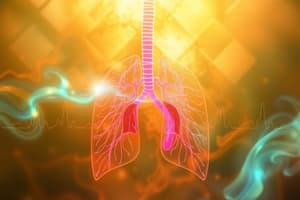Podcast
Questions and Answers
What is the normal range of pH in the blood?
What is the normal range of pH in the blood?
- 7.45-7.55
- 7.25-7.35
- 7.20-7.30
- 7.35-7.45 (correct)
What is the primary characteristic of metabolic acidosis?
What is the primary characteristic of metabolic acidosis?
- Low pH levels
- High pCO2 levels
- Low HCO3- levels (correct)
- High pO2 levels
What is the primary characteristic of respiratory alkalosis?
What is the primary characteristic of respiratory alkalosis?
- Low HCO3- levels
- High pH levels
- Low pCO2 levels (correct)
- High pCO2 levels
What is the next step after determining the pH level in interpreting an ABG?
What is the next step after determining the pH level in interpreting an ABG?
What is an example of a condition that can cause respiratory acidosis?
What is an example of a condition that can cause respiratory acidosis?
What is the term for the body's response to a primary acid-base disorder?
What is the term for the body's response to a primary acid-base disorder?
Flashcards are hidden until you start studying
Study Notes
Normal Values
- pH: 7.35-7.45
- pCO2: 35-45 mmHg
- pO2: 75-100 mmHg
- HCO3-: 22-28 mmol/L
- Base Excess: -2 to +2 mmol/L
Acid-Base Disorders
- Acidosis: pH < 7.35
- Respiratory acidosis: pCO2 > 45 mmHg
- Metabolic acidosis: HCO3- < 22 mmol/L
- Alkalosis: pH > 7.45
- Respiratory alkalosis: pCO2 < 35 mmHg
- Metabolic alkalosis: HCO3- > 28 mmol/L
Steps to Interpret ABG
- Check pH: Is the patient acidic or alkalotic?
- Determine the primary disorder: Is it respiratory or metabolic?
- Check for compensation: Is the body compensating for the primary disorder?
- Respiratory compensation: pCO2 changes in response to metabolic disorder
- Metabolic compensation: HCO3- changes in response to respiratory disorder
- Check for mixed disorders: Is there a combination of respiratory and metabolic disorders?
Examples of ABG Interpretation
- Respiratory acidosis: pH 7.20, pCO2 60 mmHg, HCO3- 24 mmol/L
- Primary disorder: Respiratory acidosis (high pCO2)
- Compensation: Metabolic compensation (increased HCO3-)
- Metabolic acidosis: pH 7.25, pCO2 30 mmHg, HCO3- 18 mmol/L
- Primary disorder: Metabolic acidosis (low HCO3-)
- Compensation: Respiratory compensation (low pCO2)
Common Causes of Acid-Base Disorders
- Respiratory acidosis: COPD, pneumonia, respiratory failure
- Metabolic acidosis: diabetic ketoacidosis, lactic acidosis, renal failure
- Respiratory alkalosis: hyperventilation, anxiety, pneumonia
- Metabolic alkalosis: vomiting, diuretic use, excessive bicarbonate intake
Normal Values
- pH ranges from 7.35 to 7.45
- pCO2 ranges from 35 to 45 mmHg
- pO2 ranges from 75 to 100 mmHg
- HCO3- ranges from 22 to 28 mmol/L
- Base Excess ranges from -2 to +2 mmol/L
Acid-Base Disorders
Acidosis
- pH is less than 7.35
- Respiratory acidosis: pCO2 is greater than 45 mmHg
- Metabolic acidosis: HCO3- is less than 22 mmol/L
Alkalosis
- pH is greater than 7.45
- Respiratory alkalosis: pCO2 is less than 35 mmHg
- Metabolic alkalosis: HCO3- is greater than 28 mmol/L
Steps to Interpret ABG
- Check pH to determine if the patient is acidic or alkalotic
- Determine the primary disorder: respiratory or metabolic
- Check for compensation: respiratory or metabolic
- Check for mixed disorders: combination of respiratory and metabolic disorders
ABG Interpretation Examples
Respiratory Acidosis
- pH is 7.20
- pCO2 is 60 mmHg
- HCO3- is 24 mmol/L
- Primary disorder: respiratory acidosis
- Compensation: metabolic compensation
Metabolic Acidosis
- pH is 7.25
- pCO2 is 30 mmHg
- HCO3- is 18 mmol/L
- Primary disorder: metabolic acidosis
- Compensation: respiratory compensation
Common Causes of Acid-Base Disorders
- Respiratory acidosis: COPD, pneumonia, respiratory failure
- Metabolic acidosis: diabetic ketoacidosis, lactic acidosis, renal failure
- Respiratory alkalosis: hyperventilation, anxiety, pneumonia
- Metabolic alkalosis: vomiting, diuretic use, excessive bicarbonate intake
Studying That Suits You
Use AI to generate personalized quizzes and flashcards to suit your learning preferences.





